Navigating Privacy and Security in the Age of Smartphones: Striking a Balance Between Convenience and Data Protection

In today's hyper-connected world, smartphones have become an indispensable part of our daily lives. These pocket-sized devices serve as our personal assistants, entertainment hubs, and communication tools, offering unparalleled convenience at our fingertips. However, as smartphones become increasingly intertwined with our digital identities, concerns about privacy and security have escalated.
Balancing the convenience of modern smartphone technology with the imperative of safeguarding our personal data presents a complex challenge. On one hand, we crave seamless integration and personalized experiences; on the other hand, we fear the potential consequences of our information falling into the wrong hands. In this article, we'll explore the intricacies of privacy and security in the age of smartphones and discuss strategies for striking a harmonious balance between convenience and data protection.
Understanding the Privacy Landscape:
The ubiquity of smartphones has led to the proliferation of vast amounts of personal data, including our location, contacts, browsing history, and even biometric information. This wealth of data is a goldmine for advertisers, app developers, and malicious actors alike. Consequently, protecting our privacy requires a comprehensive understanding of the digital ecosystem in which smartphones operate.
Data Collection Practices
Many smartphone apps collect and monetize user data to tailor advertisements, enhance user experience, or improve their services. While this data collection is often transparent, users may unwittingly consent to sharing sensitive information by accepting lengthy terms of service agreements without fully comprehending their implications.
Risks of Data Breaches
The interconnected nature of smartphones exposes users to the risk of data breaches and cyberattacks. From phishing scams to malware-infected apps, the threat landscape is constantly evolving, posing significant challenges to both individuals and organizations. A single breach can have far-reaching consequences, compromising personal privacy, financial security, and even national security.
Navigating the Balance Between Convenience and Security
Achieving a balance between convenience and security requires a proactive approach that empowers users to take control of their digital footprint without sacrificing usability. Here are some strategies for navigating this delicate equilibrium:
- Educate Yourself About Privacy Settings: Smartphone operating systems offer a myriad of privacy settings that allow users to customize their level of data sharing and device permissions. Take the time to familiarize yourself with these settings and adjust them according to your preferences. Disable unnecessary permissions for apps that don't require access to sensitive information and regularly review your privacy configurations to stay informed.
- Opt for Secure Communication Channels: When communicating sensitive information, such as financial details or personal messages, opt for secure communication channels that offer end-to-end encryption. Messaging apps like Signal and WhatsApp employ robust encryption protocols to safeguard user privacy, ensuring that only the intended recipients can access the content of your conversations.
- Implement Strong Authentication Measures: Protect your smartphone and accounts with strong authentication measures, such as biometric authentication (e.g., fingerprint or facial recognition) and two-factor authentication (2FA). These additional layers of security help prevent unauthorized access to your device and online accounts, reducing the risk of identity theft and data breaches.
- Exercise Caution When Installing Apps: Be discerning when installing apps on your smartphone and scrutinize the permissions requested by each app before granting access. Stick to reputable app developers and download apps from official app stores to minimize the risk of installing malicious software. Additionally, regularly review the permissions granted to installed apps and revoke access to any unnecessary privileges.
- Stay Informed About Privacy Policies: Stay vigilant about changes to privacy policies and terms of service agreements issued by smartphone manufacturers and app developers. Familiarize yourself with your rights as a user and exercise your right to opt-out of data collection practices that you deem intrusive or unnecessary. Consider supporting companies that prioritize transparency and user privacy in their business practices.
Conclusion: Empowering Users in the Digital Age
As smartphones continue to evolve and integrate deeper into our daily routines, the need to balance convenience with privacy and security becomes increasingly paramount. By adopting proactive privacy practices, staying informed about data protection measures, and advocating for user rights, we can navigate the complexities of the digital landscape with confidence.







